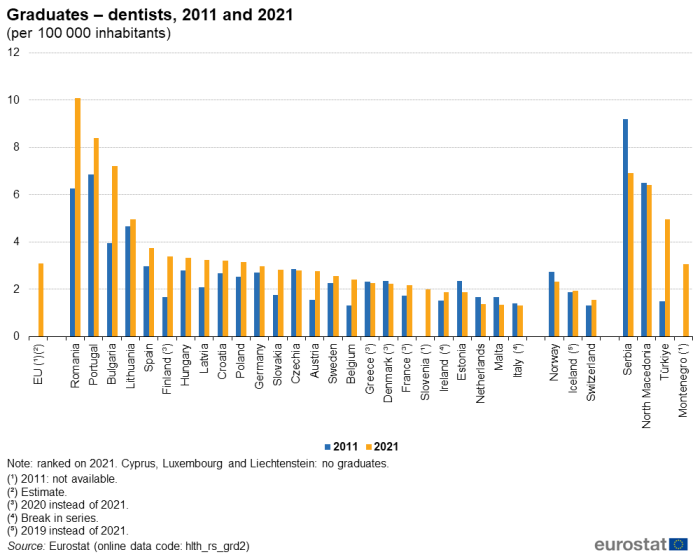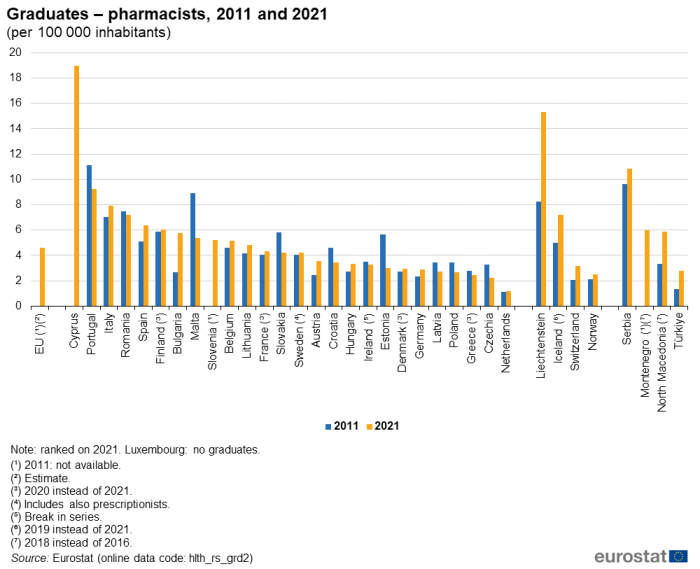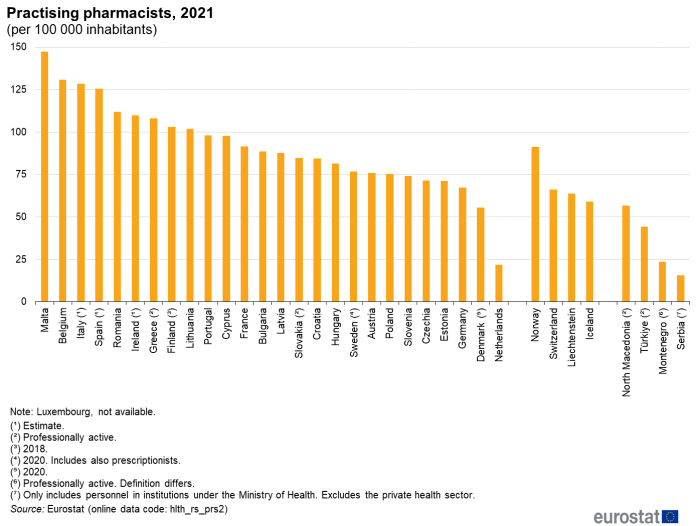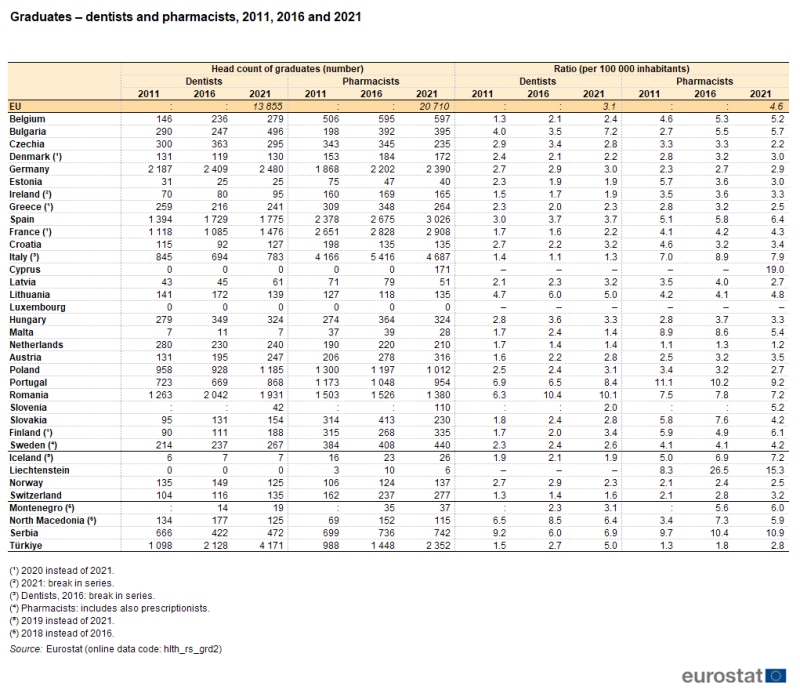Healthcare personnel statistics - dentists, pharmacists and physiotherapists
Data extracted in July 2023.
Planned article update: September 2024.
Highlights
Among the EU Member States, Greece, Portugal, Cyprus, Bulgaria, Lithuania, Romania and Estonia all reported more than one dentist for every 1 000 inhabitants in 2021.
Italy had 76 000 practising pharmacists in 2021 – the highest number across the EU Member States.
There were more than 610 000 practising physiotherapists in the EU in 2021.
Graduates – dentists, 2021
This article presents an overview of European Union (EU) statistics on dentists, pharmacists and physiotherapists. It provides information on specialist healthcare personnel, as well as data pertaining to dentistry and pharmacy graduates.
This article is one of a set of statistical articles concerning healthcare resources in the EU which forms part of an online publication on health statistics.
It should be noted that data are presented in this article for 2021. As such, this article includes data that show an impact from the COVID-19 pandemic and its related restrictions. For this reason, particular attention should be paid when comparing the 2021 data with data from earlier years.
Full article
Healthcare personnel
For dentists and pharmacists, Eurostat collects data for three concepts:
- 'practising', in other words, health care professionals providing services directly to patients;
- 'professionally active', in other words, 'practising' professionals plus health care professionals for whom their medical education is a prerequisite for the execution of their job;
- 'licensed', in other words, health care professionals who are registered and entitled to practise as health care professionals.
In this article, preference is given to the concept of 'practising' health care professionals. For some EU Member States, data are not available for this concept and therefore data are presented for one of the alternative concepts instead: footnotes indicate these exceptions in each table and figure.
Table 1 provides an overview for 2021 of the number of practising dentists, pharmacists and physiotherapists. Based on the sum of available data (see Table 1 for more details of the coverage, in particular details relating to those EU Member States which publish data for professionally active or licensed to practise healthcare professionals), there were more than 360 000 practising dentists and over 410 000 practising pharmacists in the EU Member States, while there were 611 000 physiotherapists in the EU. As such, the combined number of practising dentists, pharmacists and physiotherapists (1.4 million) was below the total number of practising physicians (1.8 million).
Greece had the highest number of dentists per 100 000 inhabitants
Dentists diagnose, treat and prevent diseases, injuries and abnormalities of the teeth, mouth, jaws and associated tissues. They use a broad range of specialised diagnostic, surgical and other techniques to promote and restore oral health.
On the basis of a comparison in relation to population numbers, Greece recorded the highest number of dentists (licensed to practise), at 130 per 100 000 inhabitants. Portugal (118 per 100 000 inhabitants; licensed to practise), Cyprus (111 per 100 000 inhabitants), Bulgaria (110 per 100 000 inhabitants), Lithuania (105 per 100 000 inhabitants), Romania (104 per 100 000 inhabitants) and Estonia (101 per 100 000 inhabitants) were the other EU Member States where there were at least 100 practising dentists per 100 000 inhabitants in 2021. Among the remaining EU Member States, the number of practising dentists per 100 000 inhabitants was generally within the range of 50–100. However, there were 46 practising dentists per 100 000 inhabitants in Ireland – see Figure 1.
There were over 410 000 pharmacists working in the EU in 2021
Pharmacists store, preserve, compound, dispense and sell medicinal products – irrespective of where they provide these services. They may also provide advice on the proper use and adverse effects of drugs and medicines following prescriptions issued by medical doctors and other health professionals.
Malta, Belgium, Italy and Spain had the highest number of pharmacists per 100 000 inhabitants
Taking into account the size of each EU Member State in population terms, Malta recorded the highest number of practising pharmacists per 100 000 inhabitants in 2021 at 147 – see Figure 2 for information concerning differences in data coverage for individual EU Member States. There were also relatively high ratios of pharmacists in Belgium (131 per 100 000 inhabitants), Italy (128 per 100 000 inhabitants) and Spain (126 per 100 000 inhabitants). The majority of the other Member States reported between 67 and 112 pharmacists per 100 000 inhabitants, although Denmark (56 per 100 000 inhabitants; 2020 data) and the Netherlands (22 per 100 000 inhabitants) both reported ratios that were considerably lower.
There were 611 000 physiotherapists working in the EU in 2021
Physiotherapists assess, plan and implement rehabilitative programs that improve or restore human motor functions, maximise movement ability, relieve pain syndromes, and treat or prevent physical challenges associated with injuries, diseases and other impairments. They apply a broad range of physical therapies and techniques such as movement, ultrasound, heating, laser and other techniques.
Germany had the highest number of physiotherapists per 100 000 inhabitants
In 2021, there were 611 000 physiotherapists working in the EU; this was equivalent to an average of 137 physiotherapists per 100 000 inhabitants. The relative distribution of physiotherapists across the individual EU Member States was more diverse than for dentists or pharmacists, ranging from upwards of 200 per 100 000 inhabitants in Germany (234) and Belgium (216) down to less than 15 per 100 000 inhabitants in Portugal (14; 2018 data) and Romania (13) – see Figure 3.

(per 100 0000 inhabitants)
Source: Eurostat (hlth_rs_prs2)
Health graduates
Table 2 presents data on the number of dentists and pharmacists graduating in the EU Member States. In 2021, there were 13 900 dentistry graduates and 20 700 pharmacy graduates in the EU.
The EU's most populous Member State, Germany, had the highest number of dentistry graduates (2 500) in 2021, while there were 1 900 dentistry graduates in Romania, 1 800 in Spain, 1 500 in France (2020 data) and 1 200 in Poland. By contrast, the highest numbers of pharmacy graduates were recorded in Italy (4 700), Spain (3 000) and France (2 900; 2020 data), all with more pharmacy graduates than Germany (2 400). There were also in excess of 1 000 pharmacy graduates in Romania and Poland.
Relative to the total number of inhabitants, Romania recorded the highest number of dentistry graduates in 2021 at 10.1 graduates per 100 000 inhabitants (see Figure 4 for more information on the data coverage for each EU Member State). Portugal (8.4 graduates per 100 000 inhabitants), Bulgaria (7.2 graduates per 100 000 inhabitants) and Lithuania (5.0 graduates per 100 000 inhabitants) also recorded relatively high ratios. The majority of the other Member States for which data are available reported between 1.9 and 3.7 dentistry graduates per 100 000 inhabitants, although the Netherlands, Malta and Italy were below this range; note that there were no graduates from degree courses in dentistry in Cyprus, Liechtenstein or Luxembourg.

(per 100 000 inhabitants)
Source: Eurostat (hlth_rs_grd2)
Cyprus recorded, by far, the highest ratio of pharmacy graduates in relation to its total population, at 19.0 graduates per 100 000 inhabitants in 2021 (see Figure 5 for more information on the data coverage for each EU Member State). The next highest ratios were recorded in Portugal (9.2 graduates per 100 000 inhabitants), Italy (7.9 graduates per 100 000 inhabitants) and Romania (7.2 graduates per 100 000 inhabitants). The majority of the other Member States for which data are available reported between 2.2 and 6.4 pharmacy graduates per 100 000 inhabitants, with relatively few pharmacy graduates in the Netherlands (1.2 graduates per 100 000 inhabitants); note that there were no graduates from degree courses in pharmacy in Luxembourg.

(per 100 000 inhabitants)
Source: Eurostat (hlth_rs_grd2)
Source data for tables and graphs
Data sources
Key concepts
Practising dentists and pharmacists, as well as physiotherapists provide services directly to patients. Dentists and pharmacists have completed university studies in their respective domains and all three professions need to be licensed to practise. Dentists and pharmacists who are working in administration, research or other posts that exclude direct contact with the patients and clients are excluded from the definition of those who are practising, whereas they are included in the definition for those who are professionally active (as long as their job requires an education in dentistry/pharmacy). The definition of dentists and pharmacists who are licensed to practise additionally includes those for whom their dentistry/pharmacy education is not a prerequisite for the execution of the job, as well as those who are unemployed, retired, or working abroad.
Data on dental and pharmacy graduates cover the number of students who have obtained a recognised qualification in dentistry or pharmacy in a given year; a university degree is generally not required to practise as a physiotherapist.
Healthcare resources
Statistics on healthcare resources (such as personnel and medical equipment) are documented in this background article which provides information on the scope of the data, its legal basis, the methodology employed, as well as related concepts and definitions.
For country specific notes on these data collections, please refer to the annexes at the end of the national metadata reports accessible from links at the beginning of the European metadata report.
Common definitions have been agreed between Eurostat, the OECD and the World Health Organisation (WHO) with respect to the employment of various health care professionals. Three main concepts are used to present these data; in this article preference is given to the concept of 'practising' dentists and pharmacists:
- 'practising', in other words, health care professionals providing services directly to patients;
- 'professionally active', in other words, 'practising' professionals plus health care professionals for whom their medical education is a prerequisite for the execution of their job;
- 'licensed', in other words, health care professionals who are registered and entitled to practise as health care professionals.
The Healthcare non-expenditure statistics manual provides an overview of the classifications, both for mandatory variables and variables provided on voluntary basis.
Symbols
Tables in this article use the following notation:
| Value in italics | estimate or provisional data; |
| Value is – | not relevant or not applicable; |
| Value is : | not available. |
Context
According to EU statistics on income and living conditions (EU-SILC), an estimated 2.9 % of the EU's population (aged 16 years and over) reported they had unmet needs for dental examination due to financial reasons in 2022; this figure was more than twice as high as the corresponding share of the population reporting they had finance-related unmet needs for medical examination (1.1 %). This difference may, at least in part, be due to national social security systems covering fewer people or a lower proportion of the total cost of dental care, resulting in some individuals having to pay a relatively large share of their dental expenses out of their own pockets (or through private health insurance).
'Dental tourism' is an area that has seen particularly rapid growth in several EU Member States in recent years, for example, in Bulgaria, Spain or Hungary, as relatively low prices, increased patient mobility, lower prices for air travel, and greater consumer confidence and awareness have led some to consider the option of having dental treatment abroad. This pattern may be expected to develop in the coming years: Directive 2011/24/EU of the European Parliament and of the Council, on the application of patients' rights in cross-border healthcare was implemented in 2013 and provides patients with increased rights and promotes cooperation between health systems.
Some health professionals seek jobs in other EU Member States. Aside from the expected benefits for the individuals concerned, their movement can impact labour markets. Directive 2005/36/EC on the recognition of professional qualifications provides a Europe-wide legal framework enabling Member States to recognise each other's qualifications. A range of health professionals – including dentists, pharmacists and physiotherapists – enjoy automatic recognition. In other words, if someone is a certified practitioner in their home Member State then they are automatically entitled to practise anywhere else in the EU. The directive also provides a set of minimum requirements for each professional activity, including the need for a compulsory university degree in order to be a dental practitioner or a pharmacist, and a minimum study/training period of four years for dental practitioners, five years for pharmacists, and three years for physiotherapists.
Direct access to
Online publications
Healthcare human and physical resources
Methodology
General health statistics articles
- Health (t_hlth)
- Health care (t_hlth_care)
- Health (hlth)
- Health care (hlth_care)
- Health care resources (hlth_res)
- Health care staff (hlth_staff)
- Health graduates (hlth_rs_grd2)
- Health personnel (hlth_rs_prs2)
- Health care resources (hlth_res)
- Health care (hlth_care)
- Healthcare non-expenditure statistics (ESMS metadata file – hlth_res)
European Union, OECD and WHO
- European Commission – Public health, see:
- OECD – Health policies and data
- World Health Organisation (WHO), see:
Other external links



